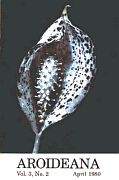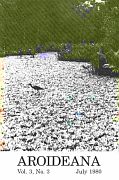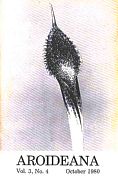|
|



Your search for articles published in volume 3 has found 34 articles.

|

| 
| 
| 
|
Articles of 3 pages or less are available for free to IAS members for download, and longer articles for $5. Articles from issues in 2016 and beyond are only available electronically, and are free to current members when they are logged in.
Please remember that all Aroideana articles are protected by copyright, and you may NOT distribute even electronic copies without permission from the authors or editor.
(Issue) |
||||
| Michael Madison, Charles Marden Fitch | Short communications
This article available FREE to IAS Members with a PERSONAL login. LOGIN, REGISTER or JOIN | |||
| Josef Bogner | The genus Scaphispatha Brong. ex Schott (Buy) | |||
| ABSTRACT: The genus Scaphispatha was published by H. W. Schott in the year 1860 using this name given by A. Brongniart in the herbarium of the Museum National d'Histoire N aturelle in Paris on the sheet of d'Orbigny's type collection from Bolivia. Scaphispatha is monotypic and the single species, Scaphispatha gracilis Brongn. ex Schott, has been collected only four times in the last 150 years. Besides the Bolivian type collection by d 'Orbigny , the three others all came from Brazil; one from Para, and the other two from the same locality in Ceara. Since the inflorescence appears before the leaves, the leaves were unknown until 1977, when living tubers collected by myself in the Serra do Araripe, Ceara, produced leaves in cultivation in the Botanischer Garten Mlinchen. Now it is possible to give a full description of this rare aroid. | ||||
| Mark D. Moffler | Qualitative observations on tropical aroid cold tolerance (Buy) | |||
| ABSTRACT: As winter approaches each year, we all become concerned about protecting our tropical plants, especially those which are the most susceptible to cold damage. The fall of 1978 was mild in Tampa, with temperatures seldom reaching below 100C (500F). The mild fall gave many of us a false sense of security and steps for cold protection were put off until "tomorrow". It wa~ this unfortunate procrastination that lead to a premature study of cold tolerance in aroids. My initial idea was to test several landscape and porch plants for cold susceptibility, but unfortunately, I unintentionally tested 46 different aroids. | ||||
| Anonymous | Errata
This article available FREE to IAS Members with a PERSONAL login. LOGIN, REGISTER or JOIN | |||
| Harald Riedl | On two aroids described in Russell's Natural History of Aleppo (1794) (Buy) | |||
| ABSTRACT: Biarum syriacum (Sprengel) H. Riedl. comb.n. and Eminium intortum (Banks et Soland.) O. Ktze. are discussed. | ||||
| Harald Riedl | Tentative keys for the identification of species in Biarum and Eminium (Buy) | |||
| ABSTRACT: The following keys have been prepared for purely practical pur: poses during a visit to the herbarium of Kew Gardens in 1978. They are based on the collections I found there, and on relevant literature published since Engler's 1920 monograph. | ||||
| Michael Madison | Aroid literature
This article available FREE to IAS Members with a PERSONAL login. LOGIN, REGISTER or JOIN | |||
| ABSTRACT: W. Crusio, 1979. A Revision of Anubias Schott (Araceae), Mededelingen Lanbouwhogeschool Wageningen, Nederlands 79-14. 48pp. is reviewed. | ||||
| Simon J. Mayo | Biarums for pleasure (Buy) | |||
| ABSTRACT: Among the general run of "bulbs" the genus Biarum undoubtedly falls into the "curiosity" category. With their low-slung inflorescences, glossy black-purple spathes and, let's face it, pretty powerful stench, the unwary lover of the more courtly Narcissus or Crocus is liable to recoil from the earthier appeal of Biarum with what must be reluctantly accepted as distaste, or in extreme cases, disgust. | ||||
| Fred Dortort | In the forests of Costa Rica (Buy) | |||
| ABSTRACT: Not long ago we had the opportunity to travel in Costa Rica for several weeks. We wanted to observe various tropical plants in their habitats, and we hoped that Costa Rica would be a good choice for our project. Aroids were one of the main groups we were looking for, and we found a large number of them. | ||||
| Harald Riedl | The importance of ecology for generic and specific differentiation in the Araceae-Aroideae (Buy) | |||
| ABSTRACT: It is Meusel's (1951) merit to have pointed out the significance of growth-habit for interpreting the evolution of a particular group of plants. In his paper he chose Araceae and Lemnaceae as striking examples to prove his point. While it is rather difficult to translate the German terminology he used for those plants which produce persistent parts above the ground, the term "geophytes" fits well for all those which persist with their subterranean parts alone. Among Araceae, rhizomatous and tuberous geophytes are known. Subfamily Aroideae is composed almost entirely of members of the latter group with the exception of plants growing in water or at least swampy ground, like Lagenandra. While, according to Meusel, intermediates between rhizomatous and tuberous geophytes are found in Colocasioideae, geophytes are rare or absent in the rest of the family. | ||||
| Mark D. Moffler, Thomas B. Croat, Craig Phillips | Short communications
This article available FREE to IAS Members with a PERSONAL login. LOGIN, REGISTER or JOIN | |||
| Robert Dressler | A new name for the dwarf purple anthurium
This article available FREE to IAS Members with a PERSONAL login. LOGIN, REGISTER or JOIN | |||
| ABSTRACT: Anthurium amnicola Dressler, nom. nov. - Anthurium lilacinum Dressler, Selbyana 2: 300. 1978, not A. lilacinum Bunting, 1975 is discussed. | ||||
| Fanny Lee Phillips | On coping with monster
This article available FREE to IAS Members with a PERSONAL login. LOGIN, REGISTER or JOIN | |||
| ABSTRACT: There are a number of ways of coexisting with monsters. One of them is to throw a party and invite the monster to be the guest of honor. During the years, Amorphophallus rivieri parties have come to be a Phillips family tradition. | ||||
| Michael Madison | Aroid profile no. 6: Anthurium andreanum
This article available FREE to IAS Members with a PERSONAL login. LOGIN, REGISTER or JOIN | |||
| ABSTRACT: Anthurium andreanum Linden, III Hort. 24:43, t. 271 (1877). Writing of his discovery a year later Andre remarked, 'it is without doubt one of the most beautiful, if not the most beautiful, of all my discoveries in South America,' (Ill. Hort. 24:43, 1877). He declined to give a precise locality for the plants in fear that other collectors would set out after them, this probably at the insistence of Linden, who jealously guarded his horticultural monopolies. | ||||
| Josef Bogner | Samuel Buchet 1875-1956
This article available FREE to IAS Members with a PERSONAL login. LOGIN, REGISTER or JOIN | |||
| ABSTRACT: Samuel Buchet was a French botanist, born on May 23, 1875 in Roanne (Loire) and died on February 21, 1956 in Le Noyer (Cher), where he lived his last years. | ||||
| Marianne Knecht | The uses of Araceae in African folklore and traditional medicine
This article available FREE to IAS Members with a PERSONAL login. LOGIN, REGISTER or JOIN | |||
| ABSTRACT: In many countries of Africa much effort is now being put into research on medicinal plants, and accounts already exist which list those species that are used in some form or other in traditional African medicine. However, these accounts do not include the personal observations of botanists, who have gathered valuable information from local people during the course of their fieldwork. The following summary includes statements that I have obtained during my own field tours in Ivory Coast in West Africa. | ||||
| R. J. Henny, Eleanor M. Rasmussen | Growing and breeding Dieffenbachia (Buy) | |||
| ABSTRACT: At the Agricultural Research Center - Apopka we have been studying the breeding potential within the genus Dieffenbachia. One goal of this program is the development of new and better varieties of Dieffenbachia for commercial production in Florida. Another important objective is to study the reproductive mechanisms of fJieffenbachia and learn more of their biology and how it relates to all tropical plants in general and other aroids in particular. Such studies include research into factors affecting plant growth, flowering, pollen and seed production and storage and inheritance of various plant characteristics (leaf and petiole variegation, growth habit, etc.). | ||||
| Simon J. Mayo | Aroid symposium at Selby Gardens
This article available FREE to IAS Members with a PERSONAL login. LOGIN, REGISTER or JOIN | |||
| ABSTRACT: At the end of March a unique event in the history of aroid botany took place in Sarasota, Florida, when the Marie Selby Botanical Gardens hosted a symposium on the Systematics and Biology of the Araceae. The conference, organized and directed by Dr. Michael Madison, marked the coming together of specialists on the family from USA, Great Britain, West Germany, Yugoslavia, Ivory Coast, Venezuela, and India, and represented the largest gathering of aroid experts ever held. | ||||
| Josef Bogner | On two Nephthytis species from Gabon and Ghana (Buy) | |||
| ABSTRACT: Nephthytis hallaei (Bogner) Bogner comb. nov. Callopsis hallaei Bogner, Adansonia, ser. 2, 9: 285-291, pI. 1 (1969). and Nephthytis swainei Bogner sp. nov. are described. | ||||
| Anonymous | 93
This article available FREE to IAS Members with a PERSONAL login. LOGIN, REGISTER or JOIN | |||
| Richard C. Sheffer, William L. Theobald, Haruyuki Kamemoto | Taxonomy of Anthurium scandens (Araceae) (Buy) | |||
| ABSTRACT: Anthurium scandens (Aublet) Engler is the most common and widely distributed of all Anthurium species ranging throughout the West Indies and tropical Central and South America. The habit is generally a small, vining, inconspicuous, usually epiphytic aroid. Specimens are occasionally cultivated for their attractive fruits which are sometimes eaten. In the past, the strong and flexible stems were used for making baskets and for tying together the framework of huts (Standley, 1937). | ||||
| R. J. Henny, Eleanor M. Rasmussen | Producing Dieffenbachia from seeds
This article available FREE to IAS Members with a PERSONAL login. LOGIN, REGISTER or JOIN | |||
| ABSTRACT: Although the flower structure and pollination method are known (1), difficulty in obtaining seed from selected crosses is a major reason that few hybrid Dieffenbachia exist. However, recent studies at the Agricultural Research Center - Apopka concerned with environmental factors affecting seed production in Dieffenbachia have led to greatly improved seed yields and made hybrid production easier. | ||||
| R. J. Henny, Eleanor M. Rasmussen | Stimulation of flowers in Dieffenbachia
This article available FREE to IAS Members with a PERSONAL login. LOGIN, REGISTER or JOIN | |||
| ABSTRACT: Dieffenbachia breeding has been hindered by sporadic flowering and the small number of inflorexcences per plant. In attempting to surmount this problem we initiated experments to see if it would be possible to control flowering using the plant hormone gibberellic acid (GA3,. The study was conducted on full-sized plants of Dieffenbachia maculata 'Perfection' grown in 6-inch pots. Treated plants were sprayed on their upper and lower leaf surfaces until runoff with either 250, 500 or 1000 parts per million GA3 while control plants were sprayed with water only. Ten plants were tested at each of the four GA3 levels and plants were maintained in a greenhouse held at 65-90oF temperature range. GA 3 was tested because it had previously been shown to induce flowering in many crops as well as some aroids (1,2,3,4). | ||||
| J. Richard Shelton | Aroid profile no. 7: Gymnostachys anceps
This article available FREE to IAS Members with a PERSONAL login. LOGIN, REGISTER or JOIN | |||
| ABSTRACT: Gymnostachys anceps R. Br., Prodr. F. Nov. Holl. I: 337. (1810). Gymnostachys is considered primitive in the Araceae family, and is not particularly related to Acorus calamus, even though, superficially it rather resembles A. calamus. No part of the plant - flowers, berries or leaves - has the characteristic odor. As one might recall, A. calamus leaves and stems have a characteristic sweet odor, and in fact, because of its odor, it is commonly called "sweet flag." | ||||
| Michael Madison | A new species of Ulearum from Brazil
This article available FREE to IAS Members with a PERSONAL login. LOGIN, REGISTER or JOIN | |||
| ABSTRACT: Ulearum reconditum Madison, sp. nov. is described. | ||||
| Libby Besse | The native south Florida aroids
This article available FREE to IAS Members with a PERSONAL login. LOGIN, REGISTER or JOIN | |||
| ABSTRACT: Orontium aquaticum, Peltandra virginica, and Pistia stratiotes are native to southern Florida, though by no means are they limited to Florida. | ||||
| Niels Jacobsen | Does Cryptocoryne ferruginea flower at full moon? (Buy) | |||
| ABSTRACT: In September 1978, Josef Bogner, Botanishcher Garten, Mtin~ chen, and I made a trip to Sarawak. The main aim of the trip was to study the Araceae of Sarawak, and among them the c. 12 species of Cryptocoryne that occur there. Coming to the end of our stay in Sarawak, we were, one evening, discussing the results of our stay and the question arose why we had not found Cryptocoryne ferruginea. | ||||
| Michael Madison | Aroid literature: Three dissertations and monographs
This article available FREE to IAS Members with a PERSONAL login. LOGIN, REGISTER or JOIN | |||
| ABSTRACT: de Granville, J. J., 1978. Recherches sur la flore et la vegetation Guyanaises, Th~se, Academie de Montpellier, 272 pp. Blanc~ P., 1978 Aspects de la ramification ches des Aracees tropiacles, These, L'Universite Peirre et Marie Curie, Paris. and Treiber, M.,1980. Biosystematics of the Arisema triphyllum complex. Thesis; Univ. of North Carolina, Chapel Hill, 357 pp. are reviewed. | ||||
| Niels Jacobsen | A new species of Cryptocoryne from Sumatra
This article available FREE to IAS Members with a PERSONAL login. LOGIN, REGISTER or JOIN | |||
| ABSTRACT: Cryptocoryne villosa N. Jacobsen sp. nov. is described. | ||||
| B. Frank Brown | Aglaonema: New discoveries (Buy) | |||
| ABSTRACT: This past March, Dr. Gutierrez learned of a newly discovered stand of Agiaonema in the wilds of the province of Rizal, on the island of Luzon. His information came from Mr. Zach Sarian, a Filipino member of the Aroid Society. Directions as to the precise location where the plants were discovered were scanty, but, after gleaning as much information as possible, we set out in quest of their habitat. | ||||
| Dow Arien, Vince Sims, Joe Wright | Short Communications
This article available FREE to IAS Members with a PERSONAL login. LOGIN, REGISTER or JOIN | |||
| Tom Ray | Syngonium oduberi (Araceae): A new species from the Osa Peninsula of Costa Rica
This article available FREE to IAS Members with a PERSONAL login. LOGIN, REGISTER or JOIN | |||
| ABSTRACT: Syngonium oduberi T. Ray, sp. nov. is described. | ||||
| Craig Phillips | Aroids in the public aquarium
This article available FREE to IAS Members with a PERSONAL login. LOGIN, REGISTER or JOIN | |||
| ABSTRACT: As every hobbyist knows, aquatic plants are both an aesthetic and a desirable complement to tropical fish tanks in the home. However, in the average public aquarium where individual tank capacity may be measured in thousands of gallons, decorative plants are usually either made of plastic or else notable by their absence, a fact on which visitors often comment. | ||||
| Josef Bogner | The genus Bucephalandra Schott (Buy) | |||
| ABSTRACT: The genus Bucephalandra Schott has been for a long time misinterpreted, because of an inaccurate description and an erroneous drawing by Schott (1858, 1860) showing a parietal placentation and the absence of flat staminodes between the female and male flowers. It seems that nobody since Schott has examined the holotype of Bucephalandra motleyana Schott, the type species. The holotype, Motley 404 (K), clearly shows a basal placentation and flat staminodes between the female and male flowers. | ||||
All Images and Text © 1996 to 2025 by the International Aroid Society or by their respective owners as noted.
Please send your comments to
served by aws-web2
